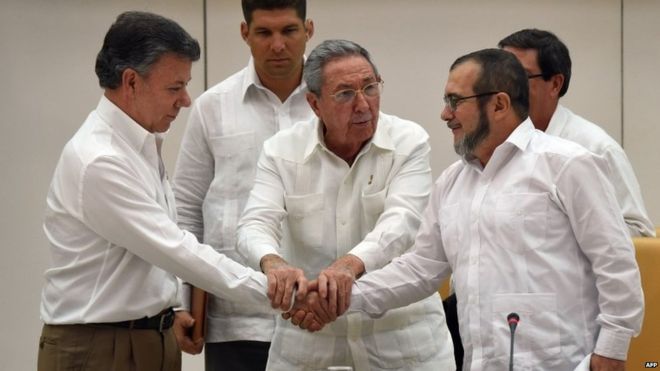War & Conflict
Colombia peace deal – A Historic agreement of 2016

The Colombian government and left-wing Farc rebels are set to sign a historic agreement deal that formally brings an end to 52 years of civil war.
The last of the major Cold War conflicts killed 260,000 people and left six million internally displaced.
President Juan Manuel Santos and rebel leader Timoleon Jimenez, known as Timochenko, will use a pen made from a bullet to sign the deal on Monday.
The president says the deal will boost economic growth and unite the country.
“War is always more costly than peace,” he said in an interview with the BBC, warning that it will take time for Colombian society to recover from more than five decades of conflict.
Under the deal, the Farc will be relaunched as a political party. The agreement will be put to Colombian voters in a popular vote on 2 October.
It comes after four years of talks in Havana, Cuba, between President Santos and Timochenko, The pair will shake hands on Colombian soil for the first time.
About 2,500 foreign and local dignitaries are to attend the signing ceremony in the walled, colonial city of Cartagena.
The president said the decision to use a bullet-pen was intended to illustrate Colombia’s transition from a country of bullets into a country of “education and future”.
Correspondents say President Santos has risked his political future on the success of the peace deal.
President Santos: From hawk to dove
Dignitaries attending the ceremony include UN Secretary General Ban Ki-moon, US Secretary of State John Kerry and Cuban President Raul Castro.
“This step that your country is going to take is a giant step,” Mr Kerry said as he arrived in the country.
He praised the efforts of Mr Santos to secure the deal and and pledged $390m (£300m) to help implement it.
The US is not yet ready to remove the Farc from its list of terrorist organisations, he said, but is prepared to review that sanction once the peace agreement is up and running.
However the EU has decided to “suspend” the Farc from its list.
“This decision will take effect upon the signature of the Peace Agreement,” the EU foreign policy chief Federica Mogherini said in a statement.
Correspondents say that although there is widespread relief that the deal may bring an end to the kidnappings and bloodshed that have blighted Colombia over five decades, it has also led to divisions in Latin America’s fourth-biggest economy.
Some are angry that it allows rebels to enter parliament without serving time in prison.
Farc rebels must now hand over weapons to the UN within 180 days.
BBC chief international correspondent Lyse Doucet says that if polls are to be believed, a majority of Colombians will vote to accept the deal.
The Farc’s 52-year fight
1964: Set up as armed wing of Communist Party
2002: At its height, it had an army of 20,000 fighters controlling up to a third of the country. Senator Ingrid Betancourt kidnapped and held for six years along with 14 other hostages
2008: The Farc suffers a series of defeats in its worst year
2012: Start of peace talks in Havana
2016: Definitive ceasefire